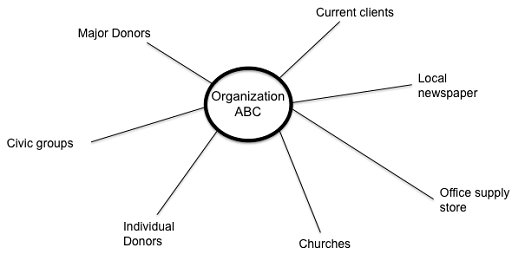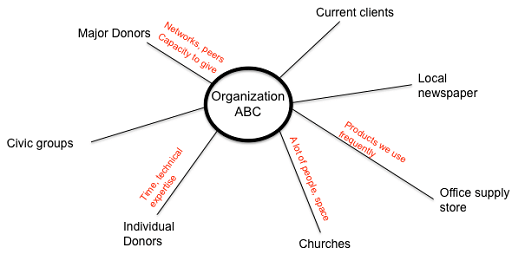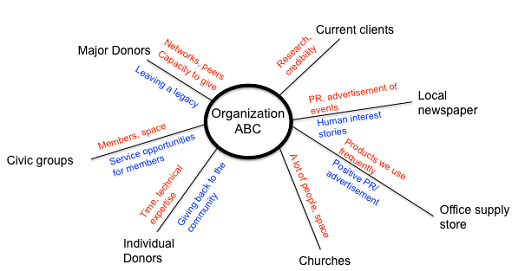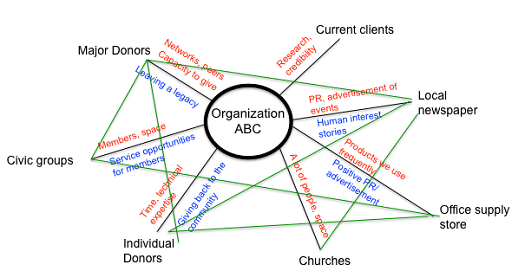Expanding Your Donor Network
As much as nonprofit organizations try to retain donors, there are always a number who will drop off the donor roles each year. When these donors are significant contributors to an organization, this can be create a sudden loss of anticipated income. To maintain a healthy, sustainable organization, it is important to always be prospecting for new donors.
This resource outlines ways that you can leverage your existing donors and networks to cultivate and retain new donors and volunteers for your organization.
The Need
Today, it is harder than ever to retain a donor. On average, an organization retains 27% of its new donors each year, which means that three out of four donors are lost every year.[1] The news is less dire for animal welfare, and international relief organizations, all of whom saw increases in new donors over the past several years, primarily due to major natural disasters. However, for organizations in the arts, health, and human services, donor decline is a significant – and growing – issue.
In addition, many nonprofits are finding it difficult to attract new donors. Since 2005, the number of donors an organization acquires each year has been falling a median of 3.5% each year.[2] This means that if an organization had 100 new donors last year, it will likely only have 96 new donors next year. The cumulative effect of accessing fewer new donors each year can quickly become a significant issue. The average retention rate of donors who have given more than once is not much better at 49%.[3] While nonprofits have an opportunity to focus on donor retention strategies, these statistics demonstrate the importance of continually cultivating new donors.
Mapping Your Way to New Donors
One of the best ways to discover new donors is by completing a “treasure map” exercise.[4] Because this is a brainstorming exercise, it is best done with a group of people. This can be completed as part of a board meeting, a staff meeting or even an annual board or staff retreat.
Step 1: Who Do You Know?
Begin by writing down your organization’s name in the middle of a large piece of paper or on a flipchart. Then, write down every person, organization or group that your organization comes in contact with over the course of a year, drawing a line connecting the organization to the contact. Having a number of people involved in this process will make it easier to think of all the people and groups that are part of your organization. Consider:
- Current clients.
- Former clients.
- Vendors
- Staff and former staff.
- Donors, volunteers, board members.
- Civic groups, political groups, religious affiliations.
- Neighbors/neighboring organizations.
As you begin, your chart may look something like this:

Step 2: What Does Each Group Have In Abundance?
A basic tenet of fundraising is to make sure you are asking for individuals and organizations have available to give; there is no sense in asking for something they cannot provide. The next step of the treasure map exercise is to identify what each person, group or organization has in abundance.
For example, churches have a lot of people, they often have space, and they may have financial resources. Office supply stores have a lot of product, including items your organization uses frequently, such as printer toner. Major donors have the capacity to give, but some may also have access to networks of peers who may also be donors. Individuals will usually have time, money or technical expertise but usually not an abundance of all three.
At this stage in the process, do not limit your thinking in this stage of the process to the specifics of what you would ask for. We know that office supply stores receive hundreds of requests for toner and probably won’t be able to provide your organization with an annual supply for free. However, what this exercise does is help you to think through what the organization has a lot of so that you can go back and structure a more appropriate ask. It can also help you think through opportunities for donations, such as space, product, or technical expertise that you may not have previously considered.
After writing these down on the map next to the associated connections, your map may begin to look something like this:

Step 3: What’s In It For Them?
We realize that giving is not a transactional process. Ideally, giving is a true expression of philanthropy, where a donor contributes because they want to support your mission and wants nothing in return. It is important, however, to realize that everyone has a self-interest. For a donor, it may be a need to feel like they are leaving a legacy or contributing in a positive way to the development of their community. Other types of donors, such as corporations, may want to support an organization and also receive positive PR from its affiliation with a community nonprofit.
The next step of this exercise is to go through each of your individuals, groups or organizations and try to identify their self-interest, noting it accordingly. In addition to focusing on donors, it is important to remember the self-interest of entities that would be able to contribute something other than cash. For example, a civic group may need to provide service opportunities for its members which it could do through one of your volunteer programs. Or your town’s local newspaper may need human interest stories which your organization can provide.
Your map may begin to look something like this:

Step 4: Who Is Missing?
Once you have identified the major individuals and groups who are connected with your organization, identified what they have a lot of as well as their self-interest, it is time to take a step back and see who is missing. Think through the key influences in your industry. If you work in healthcare, is there a prominent researcher or organization that would give credibility to your mission if you were somehow affiliated with them? If you are a local social service organization, is there a local celebrity who has an interest in your mission and could raise awareness of your cause? Are there other national or international leaders or influencers who could champion your cause? Are there other organizations with whom you could partner?
Add names of any missing individuals, groups or organizations to your chart. It is important to remember that since this is a brainstorming session, people may have additional thoughts after the session. Keep your treasure map as a work in progress, and encourage staff, board members and/or volunteers to update it as they get new ideas or make new connections.
Step 5: Who Talks to Each Other?
Once you have a visual of everyone affiliated with your organization as well as several people or groups you would like to have affiliated with your organization, the next step is to draw lines between the entities that talk to or interact with each other. For example, your board members probably interact with some of your donors and other volunteers. A current client may have connections to a local politician who is on your “wish list” of people you want affiliated with your organization. A leader at a local place of worship most likely talks to other leaders at other places of worship, including the one on your target list.
Although your map can get messy by drawing the connection points, it is important to visually see all the ways in which people and groups interact with each other. This exercise can also help you plan a strategy for accessing some of the individuals or groups you have on your list of entities you wish were affiliated with your organization.
As you begin to conclude, your treasure map may look something like this:

Using Your Map: Making Connections
Once you have completed the treasure map exercise, ask each participant in the process to “own” three groups or individuals that are on your map. For example, someone can select to work with the local office supply store to see what their policies for giving are. Someone else can contact a former program participant who now works for an organization with whom you would like to be affiliated.
At this point in the process, it is not unusual to have a list of individuals who you don’t really know. These are often your key donor prospects, and it can be difficult to know what to do next. Use your treasure map to determine any possible points of connection, and then contact the prospect and simply ask them for their advice. A few questions can include:
- What do you know about our organization?
- How could we tell our story better?
- What do you feel are the most pressing issues facing our community today?
- How do you think we could better serve our community?
Asking a few questions will give you a good idea of how interested the prospect is in your organization. It is entirely appropriate to ask if you could provide them with more information and/or if they would be interested in attending an upcoming event.
Through this exercise, you may also discover people who were at one time affiliated with your organization but who are no longer active. These may include past donors, former board members, and former staff and volunteers. Nonprofit organizations often overlook the contributions and connections of these “former” individuals, particularly past staff and volunteers. Again, you can use a series of questions to reconnect with these individuals and help them become engaged again in your organization. Suggested questions include:
- How did you first come to be involved with us?
- What did you like about being affiliated with us (working/volunteering with us)?
- What is your favorite memory of our organization?
This can give you important feedback on each person’s specific areas of interest in your organization, and it can also help establish even more connections. For example, you may find out that a former staff member or donor is connected to current donors or volunteers. Be sure to record all of the information you learn in your organization’s database, and, when appropriate, develop a strategy for reconnecting with each of the individuals you contact.
Conclusion
While we are all tempted to look for the silver bullet solution to finding major donors, it is important to remember that fundraising is an on-going, long-term system and strategy. Integrating the Treasure Map exercise into your annual planning and strategy can help keep your staff, board and volunteers focused on making new connections, seeing relationships between existing connections, and finding making appropriate asks of time, talent and resources.
Articles for Further Reading
- Additional statistics on the industry standards for donor retention http://www.npengage.com/acquisition/acquisition-trends-and-new-donor-stewardship/#sthash.CawIssSE.dpuf
- Strategies for retaining donors: http://www.frogloop.com/care2blog/2013/2/11/strategies-to-increase-nonprofit-donor-retention-rates.html#ixzz2XukMnTKk
[1] Longfield, Chuck. “Acquisition Trends and New Donor Stewardship.” 28 January 2013. http://www.npengage.com/acquisition/acquisition-trends-and-new-donor-stewardship/#sthash.CawIssSE.dpuf
[2] Nonprofit Times. 07 April 2011. http://www.thenonprofittimes.com/news-articles/donors-still-eroding-but-gifts-getting-larger/
[3] Kapin, Allyson. Strategies to Increase Nonprofit Donor Retention Rates. 11 February 2013. http://www.frogloop.com/care2blog/2013/2/11/strategies-to-increase-nonprofit-donor-retention-rates.html - ixzz2XukMnTKk
[4] Adapted from the Treasure Map Exercise from Raising More Money, now called Benevon.
